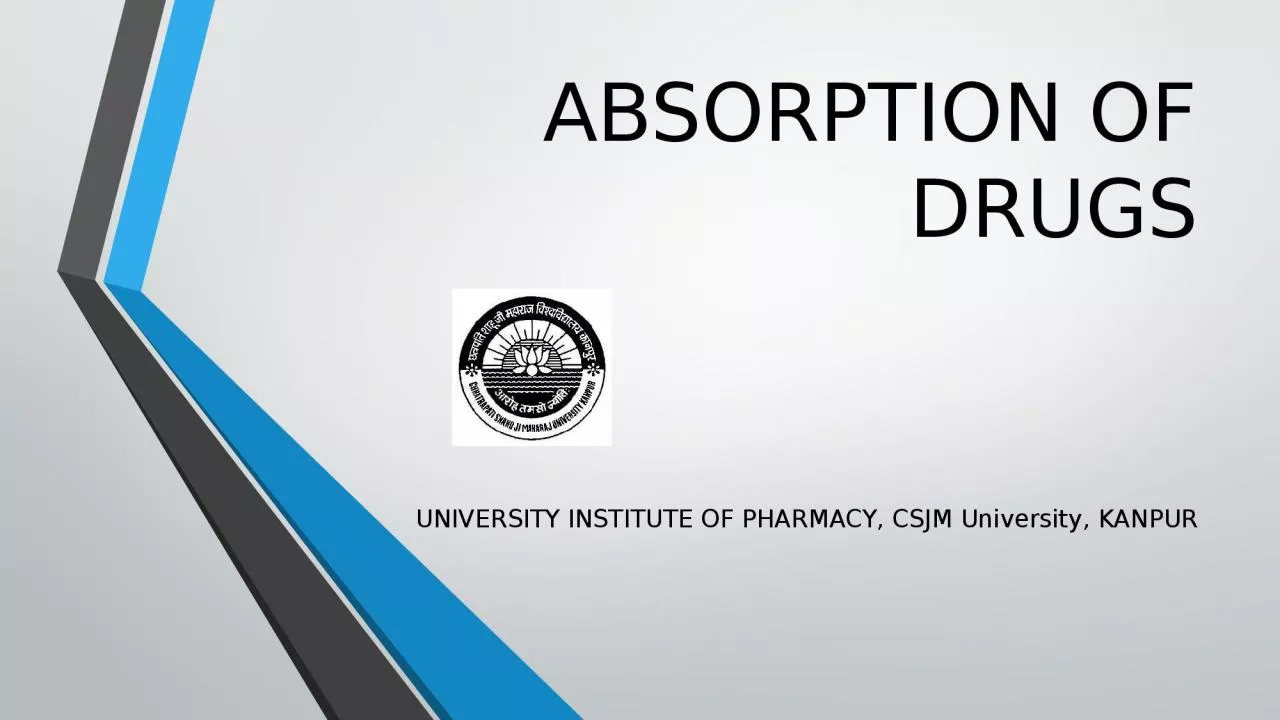

Absorption of drugs Definitions Absorption of drugs can be defined as a process of movement of drug from the site of administration to site of measurement ie systemic circulation in its unchanged form ID: 1018879
Download Presentation The PPT/PDF document "ABSORPTION OF DRUGS UNIVERSITY INSTITUTE..." is the property of its rightful owner. Permission is granted to download and print the materials on this web site for personal, non-commercial use only, and to display it on your personal computer provided you do not modify the materials and that you retain all copyright notices contained in the materials. By downloading content from our website, you accept the terms of this agreement.
1. ABSORPTION OF DRUGSUNIVERSITY INSTITUTE OF PHARMACY, CSJM University, KANPUR
2. Absorption of drugsDefinitions – Absorption of drugs can be defined as – a process of movement of drug from the site of administration to site of measurement i.e. systemic circulation, in it’s unchanged form.study of absorption of a drug is necessary for-To determine the frequency of its administration.To estimate the duration of effective action; andTo predict the onset of desired or undesired effects of the drug.2
3. BIOAVAILABILITYIt can be defined as the rate and extent of absorption of unchanged/ active form of drug. Order of bioavailability – parenteral > Oral > Rectal > Topical (with few exception)Bioavailability dependents on absorption, there will be no bioavailability without absorption. 3
4. what happens with Drug4
5. CELL MEMBRANESelectively permeableAllows some substances to cross more easily than othersMade of phospholipids, proteins & other macromoleculesThickness ~ 25 AngstromContains aqueous pores ~ 4-10 Angstrom, so it permits the small water soluble molecules like UREA.As cells are omnipresent in body, i.e. in blood vessel, capillaries etc. so drug need to penetrate through cells in order to get absorbed. This compels us to completely understand the cell membrane structure.5
6. MECHANISM OF DRUG ABSORPTIONPassive diffusion Pore transportFacilitated diffusionActive transport – 1. Primary active transport 2. Secondary active transport – symport and antiport Ion pair formationEndocytosis – phagocytosis, pinocytosis, transcytosis. 6
7. Passive diffusionMajor process for absorption of most of the drugsNon ionic diffusionDriving force – concentration or electrochemical gradientRate of transfer – directly proportional to area, concentration gradient and inversely proportional to thickness of membrane.Rate of transfer – lipophilic and unionised – more - hydrophilic and ionised – less After a steady state is attained -The concentration of the unbound drug is same on both sides of the membrane if the drug is nonelectrolyte.7
8. WEAK ELECTROLYTES AND INFLUENCE OF phMost drugs are weak acids or bases that are present in solution as both the lipid-soluble and nonionized form, lipid-insoluble ionized species. (carboxylic acids and amino groups)Therefore, the transmembrane distribution of a weak electrolyte is determined by its pKa and the pH gradient across the membrane. pKa is the pH at which half of the drug is in ionized form.The ratio of non ionized to ionized drug at each pH is readily calculated from the Henderson–Hasselbalch equation:At steady state, an acidic drug will accumulate on the more basic side of the membrane and a basic drug on the more acidic side. This phenomenon, known as ion trapping8
9. Pore transportIt is also called as convective transport, bulk flow or filtration.Mechanism – through the protein channel present in the cell membrane or paracellular space.Suitable for – low molecular weight (approx. <100 D) drugs like heparin - low molecular size (4-10 angstrom in diameter) eg aspirin - water soluble drugs like atenolol - chain like/ linear compounds like acetylcholine.9
10. Facilitated diffusionFacilitated diffusion is a form of carrier transport that does not require the expenditure of cellular energy.Carriers are numerous in number & are found dissolved in cell membrane .The driving force is concentration gradient, particles move from a region of high conc. to low conc. The transport is aided by integral membrane proteins.Facilitated diffusion mediates the absorption of some simple sugars, steroids, amino acids and pyrimidines from the small intestine and their subsequent transfer across cell membranes. Eg – metformin and thymine10
11. Active transportActive transport is a form of carrier transport that does require the expenditure of cellular energy.Divided in two categories- PRIMARY ACTIVE TRANSPORT & SECONDARY ACTIVE TRANSPORTA. PRIMARY ACTIVE TRANSPORT –Direct ATP requirementThe process transfers only one ion or molecule & only in one direction. Hence, called as UNIPORT. E.g. absorption of glucoseB. SECONDARY ACTIVE TRANSPORT – The energy required in transporting an ion aids transport of another ion or molecule (co-transport or coupled transport) either in the same direction or opposite direction.2 types: Symport (co-transport) & Antiport (counter transport)11
12. Ion pair formationResponsible for absorption of compounds which ionizes at all pH values. e.g. quaternary ammonium, sulphonic acidsIonized moieties forms neutral complexes with endogenous ions which have both the required lipophilicity & aqueous solubility for passive diffusion.E.g. Propranolol, a basic drug that forms an ion pair with oleic acid & is absorbed by this mechanism12endocytosisIt is a process in which cell absorbs macromolecules like fats,insulin, starch and oil soluble vitamins like A,D,E and K by engulfing them.Also termed as vesicular transport.It occurs by 3 mechanisms:Phagocytosis – cell eatingPinocytosis – cell drinkingTranscytosis – compartment to compartment.
13. ReferencesBiopharmaceutics and pharmacokinetics A Treatise, D.M. Brahmankar, Sunil B. Jaiswal, 1995 edition, Vallabh Prakashan, page no. 5-75.Pharmacology and Pharmacotherapeutics, R.S. Satoskar, Nirmala N. Rege, S.D. Bhandarkar, 24nd edition 2015, Popular Prakashan, page no. 14-19.Goodman & Gillman’s The Pharmacological basis of therapeutics, Laurence L. Brunton, Randa Hilal-Dandan, Bjorn C. Knollmann, 13th edition, McGraw hill publishers, page no 13-18.Essentials of Medical Pharmacology, KD Tripathi, 7th edition 2013, Jaypee Brothers Medical Publishers (P) ltd., page no. 10-17.13Special Thanks to Sudhanshu Sahu, M.Pharm. (Pharmacology) Scholar of CSJM University